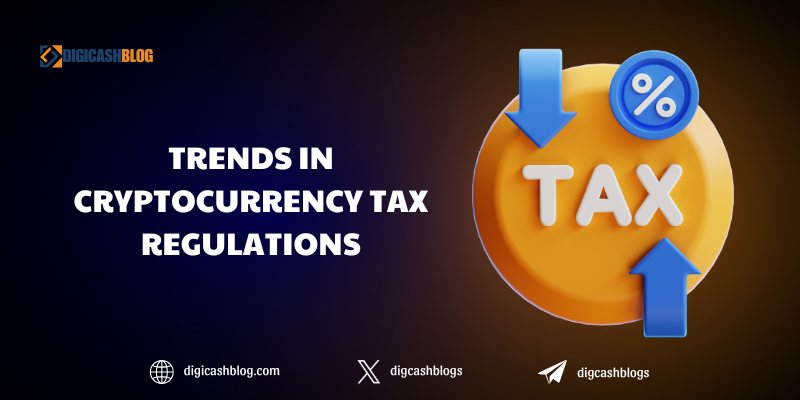Introduction to Cryptocurrency Tax Regulations
As the cryptocurrency market, valued at $2.06 trillion in 2025, continues to integrate with global financial systems, tax regulations are evolving to ensure compliance and transparency. With 659 million crypto users worldwide, trends in cryptocurrency tax regulations reflect a balance between fostering innovation and curbing tax evasion. Governments are refining frameworks to address decentralized finance (DeFi), stablecoins, and mining, impacting investors, businesses, and platforms. This article explores key regulatory trends, their drivers, challenges, and implications for stakeholders in the blockchain ecosystem.
Key Trends in Cryptocurrency Tax Regulations
Enhanced Broker Reporting Requirements
Starting January 1, 2025, U.S. cryptocurrency brokers, such as Coinbase and Gemini, must report digital asset sales and exchanges on the new Form 1099-DA, capturing gross proceeds. By 2026, brokers will also report cost basis, simplifying capital gains calculations. This aligns with the Infrastructure Investment and Jobs Act of 2021, aiming to close the tax gap. Non-custodial platforms, like DeFi exchanges, are currently exempt, but separate rules are expected by 2027. Globally, the OECD’s Crypto-Asset Reporting Framework (CARF), effective 2026 in countries like the EU and Canada, mandates similar transaction reporting, enhancing cross-border transparency.
Stricter Classification and Taxable Events
Cryptocurrencies are treated as property in jurisdictions like the U.S., subjecting transactions—sales, trades, or payments—to capital gains tax. Short-term gains (assets held less than a year) are taxed at ordinary income rates (up to 37%), while long-term gains (over a year) range from 0-20%. Non-fungible tokens (NFTs) face a higher 28% collectibles rate. Income from mining, staking, or airdrops is taxed as ordinary income (10-37%), with mining often incurring self-employment tax. In India, a flat 30% tax on virtual digital assets (VDAs) and 1% TDS on transactions above ₹50,000 persist, with no loss offsets allowed.

Stablecoin and Real Estate Transaction Reporting
Stablecoins, critical for remittances and DeFi, face heightened scrutiny. In 2025, U.S. transactions under $10,000 are exempt from reporting, but by 2026, brokers must report stablecoin sales. Real estate transactions using crypto require fair market value reporting on Form 1099-S starting in 2025, reflecting their growing use in high-value transfers. The Trump administration’s support for stablecoins, via the STABLE Act, may streamline their regulation, but transparency requirements remain stringent.
Global Harmonization Efforts
The OECD’s CARF and the EU’s Markets in Crypto-Assets (MiCA) regulation, effective December 2024, standardize tax reporting across borders. MiCA mandates unified tax obligations for EU member states, while CARF facilitates automatic exchange of crypto transaction data, reducing tax evasion. Countries like Australia and Singapore offer tax incentives, with Australia classifying Bitcoin as money, potentially refunding $640 million in capital gains taxes. However, India’s rigid 30% tax and search-and-seizure provisions contrast with tax-free jurisdictions like the UAE and Malta.
Repeal of DeFi Broker Rules
In March 2025, the U.S. Senate overturned a Biden-era rule requiring DeFi platforms to report user transactions, with a 70-27 vote reflecting bipartisan support. This decision, backed by crypto-friendly policies under the Trump administration, aims to protect DeFi’s decentralized nature. However, critics argue it may increase tax evasion risks, pushing illicit activities underground. Future regulations are expected to address DeFi compliance without stifling innovation.
Drivers of Tax Regulation Trends
Combating Tax Evasion and Fraud
With $40.9 billion in illicit crypto transactions in 2024, governments are intensifying efforts to track unreported income. Blockchain analytics, used by the IRS with firms like Chainalysis, trace transactions, reducing anonymity. Enhanced KYC/AML protocols and broker reporting align with global AML/CFT standards, ensuring platforms like Binance Pay comply with anti-money laundering laws.

Mainstream Adoption and Institutional Interest
The integration of crypto in payments, lending, and remittances, with stablecoins dominating 61.2% of Argentina’s crypto volume, necessitates clear tax frameworks. Institutional adoption, evidenced by $36 billion in Bitcoin ETF assets under management, requires standardized reporting to attract investment. The U.S. Strategic Bitcoin Reserve, established in 2025, signals government acceptance, driving tax policies to support digital asset growth.
Technological and Regulatory Complexity
The rise of DeFi, NFTs, and mining innovations, like methane capture for sustainability, complicates tax enforcement. Governments are responding with tailored rules, such as IRS Revenue Ruling 2024-14 on staking income, to clarify taxable events.
Trends in cryptocurrency tax regulations in 2025 signal a move toward global standardization, with CARF and MiCA setting benchmarks. By 2027, DeFi reporting rules and CBDC tax frameworks may emerge, integrating digital assets into mainstream tax systems. While crypto-friendly policies, like Florida’s proposed capital gains tax elimination, gain traction, stricter enforcement will persist to curb evasion. Stakeholders must adapt to enhanced reporting and leverage technology to stay compliant.
